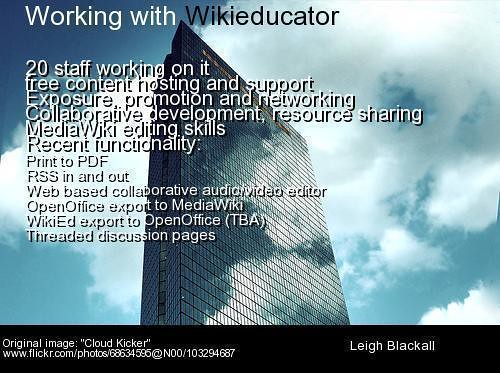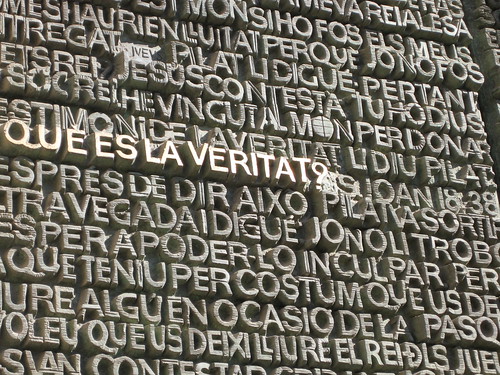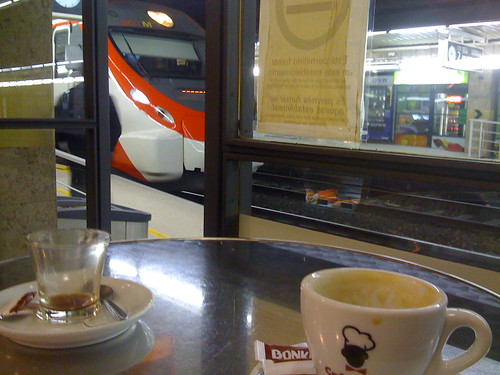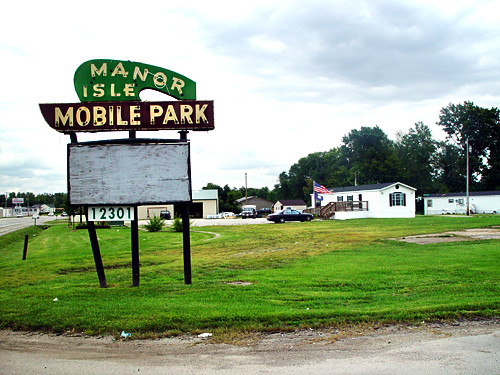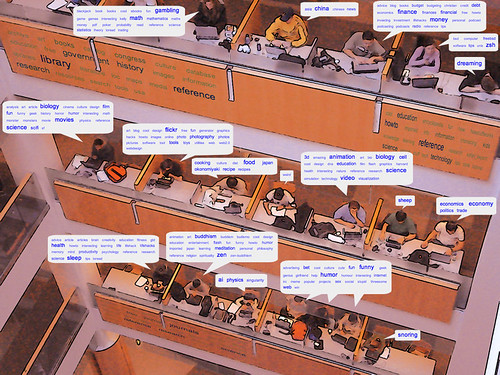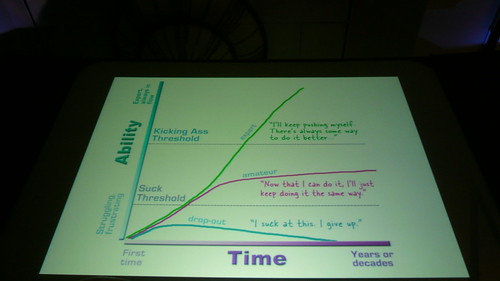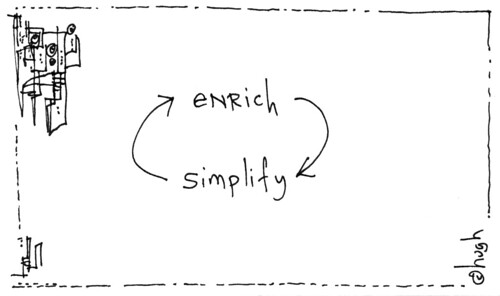
Photo by Juan Freire
Being an anxious sort, I’ve worried a lot about whether I have provided my wonderful hosts at the IN3 at the UOC (not to mention my accommodating peers at OLT-UBC) with fair value for the considerable investment involved with bringing me over to Barcelona for a month.
So when Julià Minguillón invited me last week to be a collaborator for a book chapter he is putting together on content management and e-learning I was both a little relieved and more than a little intimidated. I told him that while I did not feel qualified to add much in terms of traditional approaches to educational content management, or the emerging deep semantic web, I did think there were some important considerations I would be happy to try and articulate. (Not that he needs me to express a web-savvy perspective.)
This effort aligns quite nicely with another article I am planning with a wonderful friend (which will be blogged when the time is right), as well as an ongoing need to work towards a campus digital content strategy at UBC with our many stakeholders.
So below the jump are my preliminary thoughts as I enter the process. As ever, any feedback is gratefully received (and evidence to the contrary, thought about)… I would especially appreciate pointers to sources that have made it to the ‘established’ publications. In my own opinion, most of what follows has been amply demonstrated in both argument and deed in the blogosphere – but I worry the book’s publishers may not agree.
The long excerpts in italics are from Stephen Downes’s The Future of Online Learning: Ten Years On, which has been a companion during my sojourn in Catalonia.The dynamic nature of digital content… syndication
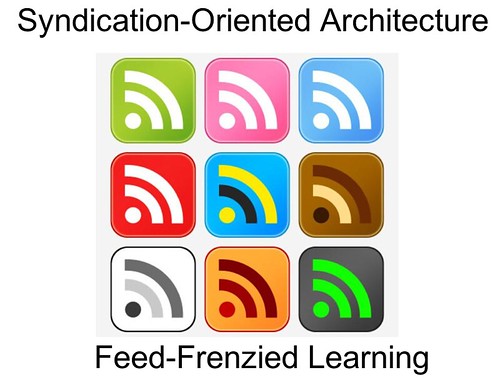
Photo by psychemedia (actually Jim Groom)
In the networked learning environment, however, learning resources are best thought of not as content objects about a discipline that are retrieved and studied, but rather as words in a multimedia vocabulary that is used by students and teachers in an ongoing conversation within a discipline to engage in projects and activities. (Downes, The New Literacy, 2002) Content and learning resources, rather than being thought of as static objects, ought to be thought of as a dynamic flow. They are more like water or electricity and they are like books and artifacts.
The technology of learning – and of the web generally – is evolving to accommodate flow. (Jarche, Learning is Conversation, 2005) Probably the most significant development in the last ten years has been the deployment of the Rich Site Summary standard – RSS – that allowed content creators to syndicate their writings and other creations. Using RSS feed readers, web users do not go to web pages or search for content, but rather, subscribe to RSS feeds and let the content come to them. (Downes, An Introduction to RSS for Educational Designers, 2003) (pg. 18 of .doc file)
Nobody who knows me or who follows this weblog can be the slightest bit surprised that this is my first consideration. I am still a little bit shocked at how little discussion seems to consider the profound importance of syndication (and its cousins such as embed code) as a content management strategy with potentially revolutionary effects. I could obviously say more…
The dynamic nature of content… interaction
While the traditional conception of learning objects was that designers or instructors would assemble smaller chunks of content into coherent presentations of learning material, this is rather the idea that the management of re-use would be placed directly into the learner’s hands, so that reuse could occur, not simply within a course content, but in any context where re-use makes sense.
In this way, the reuse of learning resources is consistent with the sort of reuse we see happening elsewhere on the internet. Rather than being structured to form larger wholes, individual bits of content are being remixed and repurposed to form new content objects, (Downes, e-Learning 2.0, 2005) and these content objects are being used in what amounts to a rich multi-media based conversation. From the perspective of the learner, the learning resource is like a YouTube video or a Flickr image or any other type of content: something to be shared with friends and used to express ideas and points of view. (pp 37-38 of .doc file)
I am a little fearful to bring this up, as the last time I made some tentative forays in this direction I feel I was widely misunderstood both by people who “agreed” and “disagreed” with me. (There seems to be something about this subject that makes this a common feeling.)
So instead of saying much more, I will point to some of the principles articulated by my “Learning Content Development and Delivery” group at the Open EdTech Summit:
* Content as infrastructure, thus OER has to go beyond content and enter into meaning creation.
* Content is not static: it has a source but evolves multi-directionally.
* New roles shaped by the new landscape: teachers and institutions become guides, enablers, capacity builders.
* Cultural shift: from the notion of controlling knowledge towards an open environment.
* Superiority of open content for reuse and reproduction, but as it is not static, the concept of preservation is at stake and needs redefinition.
* OERs should provide context-sensitive output formats: open distribution.
* Open quality assurance: not only open content creators, but also curators.
* Rethink copyright and fair use.
And thanks to Mara Hancock, who was part of that group (and someone I quickly realized had much to teach me about many things), for this pointer to Trent Batson’s article:
Content is now augmented content. The disciplinary knowledge has been made more accessible. Students engage with content converted into an image, or with content that has been deployed as a series of problem-solving activities, or with content that is raw out in the field.
And while I do not want to reinforce a false dichotomy between ‘content’ and ‘interaction’ (I will refer once again to David Wiley’s notion of content as infrastructure), this wonderful riff from Gardner Campbell (and all the links downstream from Udell and others) seems to say a lot about the ‘interactive’ elements of the dynamic:
Jerome Bruner’s observation continues to resonate with me: school is, to some crucial extent, always “consciousness-raising about the possibilities of communal mental activity.” The word “collaboration” is far too weak for what I’m trying to describe here. It’s more the moment one realizes a calling, within community, to be oneself most deeply by joining in the conversation.
That idea is obviously counterintuitive on one level, since college is a daunting experience for almost everyone at one time or another. Yet the idea is also utterly intuitive for anyone who’s ever stayed up late, drunk on the wine of a marvelous conversation.
Too many of our current educational paradigms focus on individual affordances. I’ll get a better job. I’ll get a degree. I’ll get tenure. I’ll get promoted. I’m not saying these aren’t important goals. Of course they are. But education is most deeply personal when it’s inter- and trans-personal, just as high-speed computing becomes truly transformative only when those machines are networked and the network’s platform (where would we be without the World Wide Web?) supports robust development.
So tonight I’m thinking that education is the platform for the human network, and the World Wide Web gives us a very powerful way to demonstrate and understand that fact.
The costs of sharing
We might think that these educational delivery systems will be delivering learning objects. This is not entirely incorrect, although a learning object today has come to be seen as more like a unit of text in a textbook or a lesson in a programmed learning workbook. It will be more accurate in the future to say ‘learning resource’, since many such resources will be available that do not conform to the traditional picture of a learning object – and may be as simply as a single image, or as complex as a simulation or training module. (pg. 15 of .doc file)
As he so often does, Martin Weller expresses a complex and little-understood truth with bracing, common-sense clarity:
…sharing is easy, frictionless. If I come across something I share it via Google shared items, Twitter, my blog, etc. If I want to share I stick it up on Slideshare, my blog, YouTube. There is a small cost in terms of effort to me to do the sharing, and zero cost in anyone wanting to know what I share. Sharing is just an RSS feed away.
But institutions don’t believe this, or know it. It used to take consortium agreements to share, conferences, best practice guides, incentives, metrics. How can all that be replaced by an RSS icon? Obviously it must be something different they reason, so for our needs we have to invent a system. Except it isn’t.
Just as the record industry thought this online stuff was something different, it couldn’t possibly relate to their chain of record shops, their carefully maintained back catalog, their army or A & R professional, their logistically beautiful distribution chain, the sophisticated marketing campaigns. All of this had to be different to this online stuff, it just didn’t make sense for all of these carefully constructed elements to be replaced by the same, messy uncontrolled online world. Except that, oh yes it did.
The moral here is that just because something used to be expensive, time consuming and complex doesn’t mean it will always be.
Weller references Clay Shirky, and the observations above complement a recent presentation by Shirky (via Ewan McIntosh) on the declining costs of group action:
As well as formal groups around certain types of photography on Flickr (like this HDR group for beginners) there are the more impromptu adhoc communities that form around just one photo. It means that whereas destination sites' half-lives were relatively short, the half-life of a "insta-community" photograph like this becomes very much longer. Flickr, in this case, is an organisation that has created more by doing less – less intervention, less 'management' of community, less structure around debate.
…All the walls have fallen around the world of information. There are horizons but no barriers. What’s the next good thing to do? The answer is likely to be: explore. Try several things at once. If someone has a million pound idea for exploiting the social web, then send them out for a long walk and lock the door behind them. Get them to come up with ten of £100,000 ideas or 100s of £10,000 ideas.
Self-publishing and user-owned platforms
The personal learning environment, however, is not based on the principle of access to resources. It should more accurately be viewed as a mechanism to interact with multiple services. (Milligan, 2006) The personal learning environment is more of a conferencing tool than it is a content tool. The focus of a personal learning environment is more on creation and communication than it is consumption and completion. It is best to think of the interfaces facilitated by a personal learning environment as ways to create and manipulate content, as applications rather than resources. (pg. 16 of .doc file)
The ability for both instructors and learners to exert meaningful control over the means of publication and communication was what first excited me about weblogs and wikis years ago, and I still think that distinction is key.
So much can and has been said in terms of user-owned platforms in terms of authenticity, authority, network effects and peer review. Then there are basic workflow, ownership and content management considerations, as efficiently expressed this week by Dave Cormier:
This idea of life long learning being connected to the platform is one that I continue to feel stronger about the more that I work on these topics. If people are continuously working in a walled garden like moodle, they are going to have to make separate copies of the work if they consider it worth keeping. They are not, for instance, using that work to build a network that will last beyond the point of the course. They are also not building a body of work that they can refer to.

Photo by e.dward
There are so many other voices in my community that have informed my evolving thinking in this regard, and I am sorry not to be directly referencing them here. (WHAT? no direct links to Jim Groom, Tony Hirst, Scott Leslie, George Siemens, D’Arcy Norman, Alan Levine, Nancy White, Leigh Blackall, Jon Beasley-Murray, Bryan Alexander, Barbara Ganley, Alec Couros, etc infinitum…?)
…educational institutions will need to see themselves as providers of learning resources (and not merely learning objects). These resources will be online services that connect students with: learning content; games, simulations, and other activities; ad hoc communities of learners; and experts and other practitioners. They will be specialized multimedia content consumption, editing and authoring systems designed to facilitate a student’s ability to perceive and perform as modeled by experts in a community of practice. (pg. 17 of .doc file)
Thank you to all my experts and friends who have guided me through this community of practice. I have miles before I sleep…




